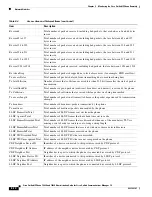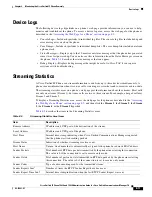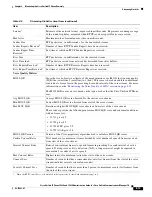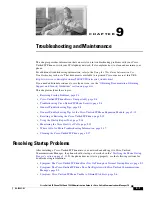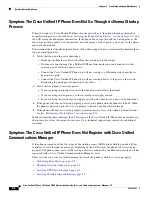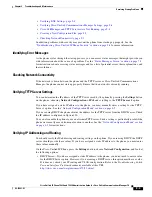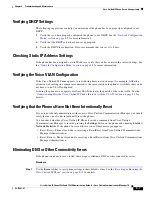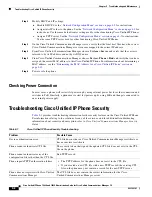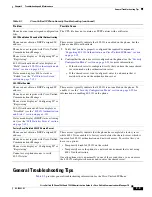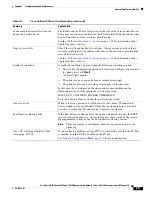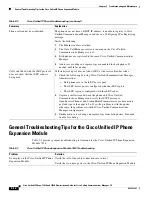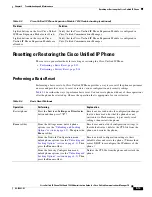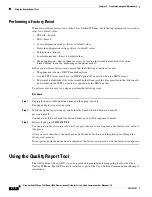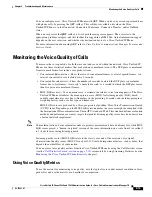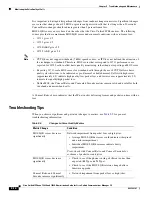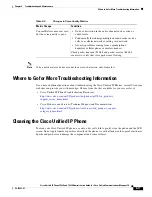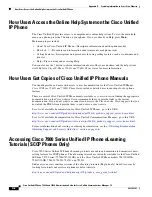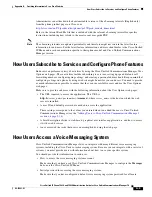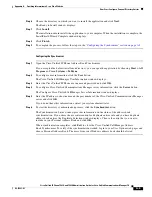
9-10
Cisco Unified IP Phone 7962G and 7942G Administration Guide for Cisco Unified Communications Manager 7.0
OL-15483-01
Chapter 9 Troubleshooting and Maintenance
General Troubleshooting Tips
Table 9-2
Cisco Unified IP Phone Troubleshooting
Summary
Explanation
Connecting a Cisco Unified IP Phone to
another Cisco Unified IP Phone/
Cisco does not support connecting an IP phone to another IP phone through the
PC port. Each IP phone should directly connect to a switch port. If phones are
connected together in a line (by using the PC port), the phones will not work.
Poor quality when calling digital cell
phones using the G.729 protocol.
In Cisco Unified Communications Manager, you can configure the network to
use the G.729 protocol (the default is G.711). When using G.729, calls between
an IP phone and a digital cellular phone will have poor voice quality. Use G.729
only when absolutely necessary.
Prolonged broadcast storms cause
IP phones to reset, or be unable to make or
answer a call.
A prolonged Layer 2 broadcast storm (lasting several minutes) on the voice
VLAN may cause IP phones to reset, lose an active call, or be unable to initiate
or answer a call. Phones may not come up until a broadcast storm ends.
Moving a network connection from the
phone to a workstation.
If you are powering your phone through the network connection, you must be
careful if you decide to unplug the phone’s network connection and plug the
cable into a desktop computer.
Caution
The computer’s network card cannot receive power through the
network connection; if power comes through the connection, the
network card can be destroyed. To protect a network card, wait 10
seconds or longer after unplugging the cable from the phone before
plugging it into a computer. This delay gives the switch enough time
to recognize that there is no longer a phone on the line and to stop
providing power to the cable.
Changing the telephone configuration.
By default, the network configuration options are locked to prevent users from
making changes that could impact their network connectivity. You must unlock
the network configuration options before you can configure them. See the
“Unlocking and Locking Options” section on page 4-3
for details.
Phone resetting.
The phone resets when it loses contact with the Cisco Unified Communications
Manager software. This lost connection can be due to any network connectivity
disruption, including cable breaks, switch outages, and switch reboots.
LCD display issues.
If the display appears to have rolling lines or a wavy pattern, it might be
interacting with certain types of older fluorescent lights in the building.
Moving the phone away from the lights, or replacing the lights, should resolve
the problem.
Dual-Tone Multi-Frequency (DTMF)
delay.
When you are on a call that requires keypad input, if you press the keys too
quickly, some of them might not be recognized.
Codec mismatch between the phone and
another device.
The RxType and the TxType statistics show the codec that is being used for a
conversation between this Cisco Unified IP phone and the other device. The
values of these statistics should match. If they do not, verify that the other
device can handle the codec conversation, or that a transcoder is in place to
handle the service.
See the
“Call Statistics Screen” section on page 7-12
for information about
displaying these statistics.

